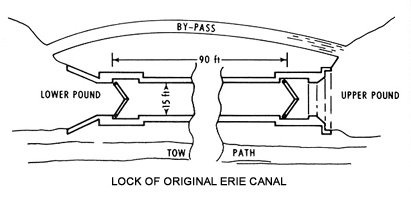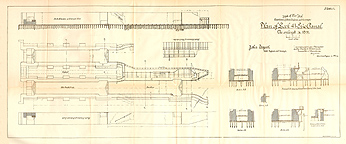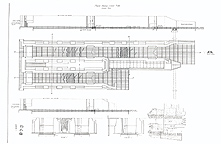
Home | Canal System | Historical Documents | 175th Anniversary
Images | Maps | Tour | Traces | Locks | Boats | Books and Videos | Music | Links



The present Erie Canal rises 566 feet from the Hudson River to Lake Erie through 35 locks. From tide-water level at Troy, the Erie Canal rises through a series of locks in the Mohawk Valley to an elevation of 420 feet above sea-level at the summit level at Rome. Continuing westward, it descends to an elevation of 363 feet above sea-level at the junction with the Oswego Canal, and finally rises to an elevation of 565.6 feet above sea-level at the Niagara River.
The original "Clinton's Ditch" Erie Canal had 83 locks. The Enlarged Erie Canal, built between 1835 and 1862, saw this number reduced to 72 locks. Today, there are 35 numbered locks -- although Lock No. 1 is usually called the Federal Lock -- plus the Federal Black Rock Lock.
In the early days of the canal, when horses and mules walked the towpath, this is how a canal boat passed through a lock:

(Animated gif by Terry Pepper; used with permission)
Today, boat owners are required to follow certain rules to "lock through". The official New York State Canal System web site has a page on Navigating the Canals which includes a section explaining How to "Lock Through" Canal System Locks.

The original Erie Canal locks were 90 feet long and 15 feet wide, and were designed for a canal boat 61 feet long and 7 feet wide, with a 3 1/2 foot draft.

[From: Hydrology and Environmental Aspects of Erie Canal (1817-99) / by W. B. Langbein
(U.S. Govt. Printing Office, 1976 (Geological Survey Water-supply Paper 2038)) -- p. 24.]
In order to keep pace with the increasing traffic on the canal, it was enlarged between 1836 and 1862, and the size of the locks was increased to 110 feet long and 18 feet wide. The enlargement included the doubling of the locks -- two parallel chambers -- enabling traffic to proceed in both directions at the same time. Although the enlargement was declared to be complete in 1862, 15 locks had not been doubled by that time, including most of those west of Port Byron. In 1869, it was decided to resume the doubling, and this was completed in 1875. A number of locks were widened to 20 feet, beginning in 1870. In 1884, it was decided to begin lengthening locks, extending one chamber to double length, allowing passage for "double-headers" -- two boats hooked together -- without the time-consuming necessity for uncoupling. Lengthening of the first lock, Lock 50, to 220 feet was completed in 1885. By 1891, Locks 23-35, 40-43, 45-56, 60-66, and 72 had been lengthened. Locks 1-18 (from the Hudson River through Cohoes), 36-39 (at Little Falls), 57-59 (at Newark), and 67-71 (at Lockport) were never lengthened.
Below are the plans for two of the enlarged, lengthened locks -- click on each image to see a larger version of the plan.
 |
 |
| Plan of Lock 41, Fort Herkimer, as lengthened in 1891. Note that the eastern (foot) end of the south (berme) lock chamber is noted as "New lock". | Plan of Lock 56, Lyons (also called the Poorhouse lock). Note that in this case, it is the north chamber that has been extended. |
For a list of Enlarged Erie Canal locks, their location and characteristics, see Table of Locks, edited from: History of the canal system of the State of New York ... / by Noble E. Whitford (Albany : Brandow Printing Co., 1906 -- p. 1105-1107).
Images of Enlarged Erie Canal locks may be found on this web site in the following locations (note that, in some cases, the locks are shown while in use, while other images are what remains today):
Between 1903 and 1918, the State again enlarged the canal by the construction of what was termed the "Barge Canal", these locks of today are 328 feet long and 45 feet wide, with a depth of 12 feet of water over the mitre-sills, and can accommodate vessels 300 feet long and 43.5 feet wide. See the Canal Profile for the height and location of the current locks.

For information and pictures of the Erie Canal of today, see "A Photo Tour of The Erie Canal" on The Travels of Tug 44 web site.
For more information about locks, including plans and details of the mechanisms, see the Making It Work: The Lock page in the 175th Anniversary Exhibit section of this web site, and to the Locks and Keys page of the 40x44x28 site.
http://www.eriecanal.org/locks.html